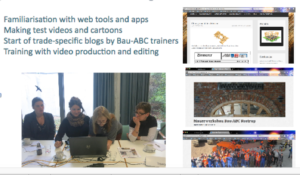Catching up with the TACCLE4-CPD project – Part Three: Drawing conclusions for future-oriented training
With my previous posts I have started a series of blogs that present my contributions to our ongoing TACCLE4-CPD project. In this project we are looking at concepts and models for continuing professional development (CPD) of teachers and trainers with emphasis on promoting their digital competences. In my first post I reported on the document that I had produced for our policy analyses (with emphasis on the field of vocational education and training (VET)). In the second post I presented my starting points for revisiting our predecessor projects – the three earlier TACCLE projects with focus on classroom teachers and the Learning Layers project with focus on vocational and workplace-based learning.
In this post I want to present a summary of my results – conclusions for future-oriented training (with emphasis on the field of VET):
“Looking back at the project histories (of the predecessor projects) it becomes clear that the project teams have been able to ‘hatch out’ of the original scripts and face challenges that were not anticipated in the proposed work plans. Therefore, it is appropriate to consider the past training concepts as impulses for a future-oriented training approach – instead of taking them as ready-made models to be replicated. In particular this is important when discussing the value of the legacy of prior TACCLE projects and the Learning Layers project for future work in the field of VET.
From this perspective it is worthwhile to pay attention to the following differences between the training concepts in the early TACCLE projects and the Learning Layers project (and its Construction pilot):
- For the TACCLE projects the key instruments for promoting the teachers’ digital competences have been the TACCLE handbooks. The TACCLE courses have been closely linked to the preparation of the handbooks and to use of their contents.
- For the Learning Layers project (and its Construction pilot) the key instrument for promoting trainers’ and apprentices’ digital competences has been the digital toolset Learning Toolbox. The training campaigns that were implemented in earlier phases of work have served as preparatory phases. However, when looking at future-oriented training for trainers, the role of such toolsets as support for vocational and work process -oriented learning needs to be taken into account.
In addition to the above-mentioned points it is necessary to consider the twofold meaning of ‘digital competences’ in the context of VET. As has been emphasised in recent studies (see Sloane et al. 2019 and Gessler & Ahrens 2019), this concept refers to mastery of ‘digitisation’ at the operative level and to mastery of ‘digital transformation’ at the level of work processes at organisational level (and across production, supply and service networks).
From this perspective it is appropriate to revisit the ‘theme room’ approach from the perspective of bringing together different training impulses and addressing different training needs with the help of different instruments to promote training and learning.
Here, it is possible to build upon the success factors of the TACCLE and Learning Layers projects. Yet, it is necessary to take into consideration critical issues and challenges that emerge in the current work with digital tools in education and training. In this respect it is possible to outline the ‘cornerstones’ of a future-oriented training model on the basis of the training concepts of TACCLE and Learning Layers projects (in particular with reference to the ‘Theme Room’ and the peer tutoring in the introduction of the Learning Toolbox). However, this legacy needs to be enriched with new experiences in the field.”
So, I have taken the course to update the “Theme Room” model and to enrich it with newer experiences from the field of VET – in particular regarding the the use of digital toolsets like the Learning Toolbox and taking into account different meanings of ‘digital competences’. There is work to be done.
More blogs to come …
PS: If someone wants to read the full document, I can send it via e-mail or share a link to Google Drive folder. PK

